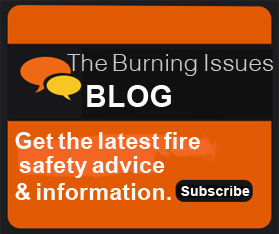We recently wrote about new fire sprinkler requirements for retirement homes and long-term care facilities in Ontario. Whether you have to meet a legal mandate or simply want to protect your property and occupants, fire sprinklers are a very effective fire safety option. They make a significant difference for preventing loss of life and minimizing damage.
Sprinklers originated in factories, before the turn of the 20th century. Back then, water “sprinkled” out of perforated pipes fed by a water barrel, which was manually operated by someone who had to stand there and open the hand valve. As with all things, sprinklers have come a long way in over 100 years.

Today, there are various types of sprinklers available to property owners in the Greater Toronto Area. These include Wet Pipe, Dry Pipe, Pre-action, Deluge and Foam Sprinklers. We’ll overview the basics about the main sprinkler types here, so you can get a general understanding of the differences and when you would want to use each type of system.
5 Ways to Meet Ontario’s Fire Sprinkler Requirement: Which is Right for You?
Wet Pipe Sprinkler Systems consist of water-filled pipes and sprinkler heads. When exposed to heat, the core of the sprinkler head will burst, enabling a flow of water. Other sprinkler heads in the system may also be activated depending upon whether they are exposed to heat. Each sprinkler head is independent and will spray water only if elevated temperature causes their core to burst. In the event of a “false alarm,” only one sprinkler head would typically go off, not the entire system. Wet pipe is the most common type of sprinkler system.
Dry Pipe Sprinkler Systems are the second most common type of sprinkler system, and are used when there is a risk of exposure to weather that could freeze the water in a wet pipe system, making it unusable. In a dry pipe system, pipes are filled with air below water supply pressure. No water enters the pipes until the sprinklers are set off. As with the wet pipe system, each sprinkler operates independently of the others. There are some potential drawbacks of dry pipe systems relative to wet pipe systems, including: increased complexity, higher costs, less design flexibility, increased fire response time, and increased corrosion potential. For this reason, they are only used when the risk of freezing outweighs the other potential disadvantages.
Foam Sprinkler Systems spray a mixture of water and foam which blocks oxygen and smothers the fire. This type of system is often used with high-hazard occupancies including workplaces with flammable liquid handling and storage or aircraft hangars.
Deluge Sprinkler Systems share a common trigger, which is a signal from the fire alarm system telling the deluge valve to open. The fire alarm system may be triggered by smoke, heat, or optical flame detectors. The heat-sensing elements present in the wet and dry pipe systems have been removed from these sprinklers, so they are not activated by elevated heat alone. Once the deluge valve is open, water enters the piping and simultaneously sprays water from all heads in the sprinkler system at once, covering the entire area. This type of system is commonly found in areas with flammable liquid handling and storage or aircraft hangars.
Pre-action Sprinkler Systems are hybrids of wet, dry, and deluge systems, based on desired function and performance. As with dry pipe systems, water is not contained in the pipes. However, where dry pipe systems are controlled by heat-sensitive cores at each sprinkler head, pre-action systems do not discharge unless a detection system identifies a fire and opens the pre-action valve. Water enters, creating a wet pipe system. Next, individual sprinkler heads must also release before water will spray. A drawback of this type of system is that it is more costly, and also requires additional maintenance to compensate for potential decreased reliability on account of its complexity. Pre-action systems are often used in museums, libraries, and data centers where accidental water discharge on valuable property would have major financial repercussions.
Other types of sprinkler systems used less frequently may include antifreeze loops, water spray, and water mist systems. If you have questions about any of these types of sprinkler systems, let us know. With decades of professional fire safety experience, Rohen is a trusted fire protection partner serving leading municipal buildings, property management companies, businesses and property owners in the Greater Toronto Area.
Additional Information:
If you are interested in fire sprinklers, you may also want to read our post on “Fire Sprinkler Safety: Good Maintenance is Your Best Defense," which covers do's and don’ts for fire sprinkler safety.
You can get additional information about fire sprinkler performance from the National Fire Protection Association here.


